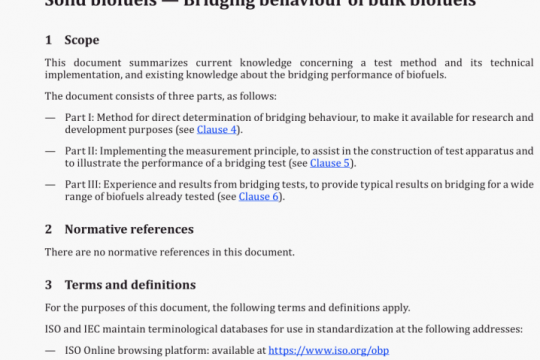ISO 3529-2 pdf free download
ISO 3529-2-2020 pdf free download.Vacuum technology一Vocabulary- Part 2: Vacuum pumps and related terms.
1 Scope
This document gives definitions of vacuum pumps and related terms. It is a continuation of Iso 3529-1
which defines general terms used in vacuum technology.
2 Normative references
ISO 3529-1:2019, Vacuum technology — Vocabulary — Part 1: General terms
ISO 21360-1:2012, Vacuum technology — Standard methods for measuring vacuum-pump performance — Part 1: General description
3 Terms and definitions
For the purposes of this document, the following terms and definitions apply.
ISO and IEC maintain terminological databases for use in standardization at the following addresses:
— ISO Online browsing platform: available at https://www.iso.org/obp
— I EC Electropedia: available at http://www.e1ectropedia.org/
3.1 Vacuum pumps
3.1.1 vacuum pump
device for creating, improving and/or maintaining a vacuum
Note ito entry: Two basically distinct categories may be considered: gas transfer pumps (11.2) and gas gathering vacuum pumps (3.1.32)
Note 2 to entry: Some definitions given in ISO 3529-1 are repeated in this document in deferent terms to adapt to vacuum pumps.
Note 3 to entry: Vacuum is defined in ISO 3529-1.
Note 4 to entry: A classification table for vacuum pumps Is described In Annex A.
3.1.2 gas transfer vacuum pumps
vacuum pump (iLl) that transports gas molecules from the Inlet to the outlet (1L3) of the vacuum pump by means of positive displacement or transfer of kinetic momentum
3.1.3 positive displacement vacuum pump
vacuum pump (3J.j) in which a volume filled with gas is cyclically isolated from the inlet, the gas being then transferred to an outlet (3.2.)
Note ito entry: In most types of positive displacement vacuum pumps the gas Is compressed before exhausted.
Two categories can be considered: reciprocating or oscillating positive displacement vacuum pumps (hA— 3J.) and rotary positive displacement vacuum pumps with single (ILZ—3.L13) or double (3.1.14-3.1.16) rotor
principle.
Note 2 to entry: Positive displacement vacuum pump are often equipped with a gas ballast system, to admit a controlled quantity of a suitable non-condensable gas during the compression part of the cycle so as to reduce or avoid the extent of condensation within the vacuum pump.
Note 3 to entry: An oil-sealed (liquid-scaled) vacuum pump is a rotary positive displacement vacuum pump in which oil (liquid) is used to seal the gap between parts which move with respect to one another and to reduce the residual free volume In the pump chamber at the end of the compression part o the cycle.
Note 4 to entry: A dry positive displacement vacuum pump is a device, where the pumping chambers are not oil- sealed (liquid-sealed).
Note 5 to entry: All types of positive displacement vacuum pumps can be combined as multi-stages of the same or differing.
3.1.4 diaphragm vacuum pump
dry positive displacement vacuum pump (11.3) in which the gas is compressed and expelled due to the movement of a reciprocating or oscillating action of a diaphragm by using suitable valves
3.1.5 piston vacuum pump
positive displacement vacuum pump (1L3) in which the gas is compressed and expelled due to the movement of a reciprocating piston moving in a cylinder by using suitable valves
3.1.6 linear peristaltic vacuum pump
vacuum pump (3..1J.) which uses linear placed actuators forcing or compress the gas through a flexible tube.ISO 3529-2 pdf free download.




